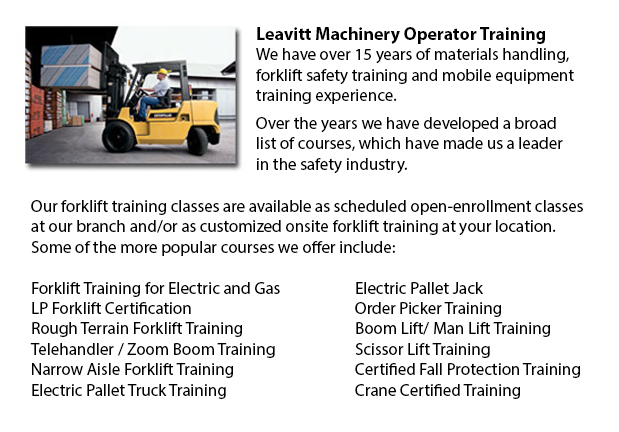
St Catharines Forklift Training School - Forklift Training School - For The Safety Of Both The Machinery And The User - CSA and OSHA establish criteria for forklift safety training that meets current regulations and standards. Anybody planning to operate a forklift is required to successfully complete safety training before using any type of forklift. The accredited Forklift Operator Training Program is intended to offer trainees with the practical skills and information to become an operator of a forklift.
There are forklift operation safety regulations which must be followed pertaining to pre-shift checks, and regulations for loading and lifting.
Prior to a shift starting, an inspection checklist has to be done and submitted to the Supervisor or Instructor. If any maintenance issue is discovered, the equipment must not be used until the issue is dealt with. To be able to indicate the equipment is out of order, the keys should be removed from the ignition and a warning tag placed in a spot that is visible.
Loading safety regulations include checking the forklift nameplate's rating capacity and knowing if the weight of the load falls within capacity. The forklift forks should be in the down position when the forklift is starting up. Don't forget that there is a loss of around 100 pounds carrying capacity for every inch further away from the carriage which the load is carried.
To safely lift a palletized load, drive the forklift to the pallet and halt with the fork three inches from the load. Level the mast until it is at right angles to the load. Lift the forks to one inch below the slot on the pallet and drive forward. Afterward lift forks four inches. Tilt back the load to be able to secure it for moving. Drive the lift backwards if the load obscures frontal vision. Check behind and honk in order to warn other staff. Do not allow forks to drag on the ground.
-
St Catharines Heavy Equipment Training Schools
St Catharines Heavy Equipment Training Schools - When selecting an operator training course, there are a lot of heavy equipment training schools to choose from. To be able to ascertain the qualifications you will attain, it is very important to explo... More -
St Catharines Heavy Equipment Operator Training
St Catharines Heavy Equipment Operator Training - Heavy equipment operator training facilities that offer quality standards within the business, offering field performance work and additional machine training are really sought after training features... More -
St Catharines Forklift Training Programs
St Catharines Forklift Training Programs - Are you looking for work as a driver of a forklift? Our regulatory-compliant mobile equipment operator training offers instruction in kinds of forklifts, pre-shift check, fuel kinds and handling of fuels, an... More -
St Catharines Heavy Equipment License
St Catharines Heavy Equipment License - A heavy equipment license can be obtained by taking a certification and preparation course at a private training school or a vocational school. This license would qualify you to operate various types of heavy e... More -
St Catharines Overhead Crane Safety Training
St Catharines Overhead Crane Safety Training - Overhead crane safety training equips operators with skills and knowledge regarding crane safety precautions, accident avoidance, materials handling, and equipment and stock protection. Trainees will lea... More -
St Catharines Scissor Lift Training
St Catharines Scissor Lift Training - Scissor lifts should be operated proficiently to be able to protect the safety of the equipment and the wellbeing of others within the workplace. Operators who are skilled are trained to drive the specific type o... More -
St Catharines Telescopic Training
St Catharines Telescopic Training - Telescopic Handlers are a kind of forklift, normally known as telehandlers. This machine has been increasing in popularity due to its greater lift heights and its versatility. It is often preferred over the convent... More -
St Catharines Boom Lift Certification
St Catharines Boom Lift Certification - Utilizing elevated work platforms allow for maintenance operations and work to be carried out at elevated work heights which were otherwise unreachable. Boom Lift Certification Training educates workers about t... More

Forklift Certification St Catharines
TOLL FREE: 1-888-254-6157
St Catharines, Ontario
forkliftcertificationstcatharines.com/
Email Us
About Us


